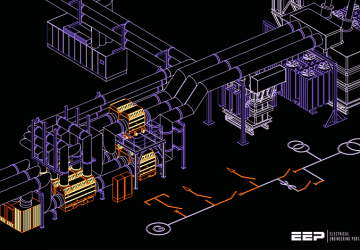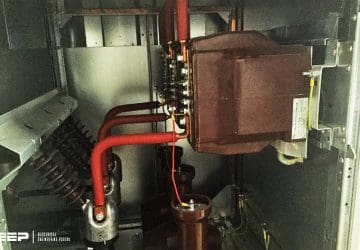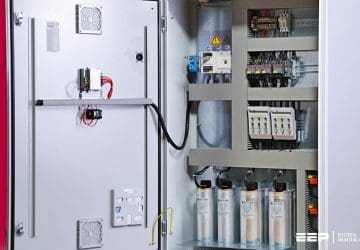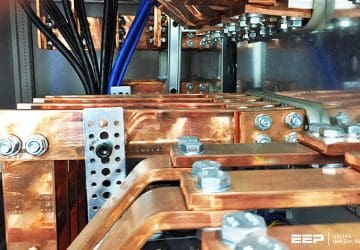Why does generator-current breaking differ from other switching devices in T&D systems
There are few switching situations that differ from the duties standardized for switching devices in transmission and distribution systems. One of these special situations are generator-current breaking. Generator circuit-breakers are breakers applied at a rated voltage matching the rated voltage…...
Membership Upgrade Required
This content is not available in your premium membership plan. Please upgrade your plan in order to access this content. You can choose an annually based Basic, Pro, or Enterprise membership plan. Subscribe and enjoy studying specialized technical articles, online video courses, electrical engineering guides, and papers.With EEP's premium membership, you get additional essence that enhances your knowledge and experience in low- medium- and high-voltage engineering fields.
Black Friday Deal 💥 - Save 20% on Pro Plan with code BLACKFRIDAY
Upgrade
Mar 09, 2018 | By Edvard Csanyi

Have you experienced an incorrectly specified CT that can’t be manufactured?
When a CT manufacturer says that he is unable to manufacture the requested CT, nine times out of ten this is because the CT has been incorrectly specified. To eliminate all the cumulated safety margins taken by all the people involved,… Read more
Mar 07, 2018 | By Edvard Csanyi

Achieving Relay Coordination and Selective Short Circuit Protection In Transmission Networks
The selected protection principle affects the operating speed of the protection, which has a significant impact on the harm caused by short circuits. The faster the protection operates, the smaller the resulting hazards, damage and the thermal stress will be…. Read more
Mar 05, 2018 | By Edvard Csanyi

Step-by-step tutorial for building capacitor bank and reactive power compensation panel
Design of reactive power compensation panel is much different and not that simple like standard distribution panel. When dealing with such panels, there are dozen of parameters to specify and other things to take care of. This article is the… Read more
Feb 28, 2018 | By Edvard Csanyi

Measurements and Calculations Of Earth Electrode Systems (BS 7430)
System earthing involves the provision of a connection to the general mass of earth. This connection should have a resistance not greater than that required to operate safety mechanisms to isolate the electricity supply from a fault situation. Second important… Read more
Feb 26, 2018 | By Edvard Csanyi

Meet the Real Heart of Power System Operations – The Transmission Control Center
The transmission control centre is the real heart of every utility’s power system operations. Typical transmission control centres have three main desks – the generation, transmission and scheduling desk. Let’s take look at three main transmission and other support desks…...
Membership Upgrade Required
This content is not available in your premium membership plan. Please upgrade your plan in order to access this content. You can choose an annually based Basic, Pro, or Enterprise membership plan. Subscribe and enjoy studying specialized technical articles, online video courses, electrical engineering guides, and papers.With EEP's premium membership, you get additional essence that enhances your knowledge and experience in low- medium- and high-voltage engineering fields.
Black Friday Deal 💥 - Save 20% on Pro Plan with code BLACKFRIDAY
Upgrade
Feb 23, 2018 | By Edvard Csanyi

Losses in the power transmission system and short, medium and long line model analysis
Like all other power system systems, no matter how carefully the system is designed, losses are present and must be modeled before an accurate representation of the system response can be calculated. Due to the size of the area that… Read more
Feb 21, 2018 | By Edvard Csanyi

Essential considerations on the neutral and protective conductor in LV power system
The neutral conductor is a live conductor that is connected to the neutral point of the system and is able to contribute to the transmission of electric power. The neutral point is usually, but not necessarily connected to the star-point… Read more
Feb 19, 2018 | By Edvard Csanyi

AC Auxiliary Systems In Power Substations (Design Requirements and Equipment)
Substation AC auxiliary systems are typically used to supply loads such as transformer cooling, oil pumps, and load tap changers, circuit breaker air compressors and charging motors, outdoor device heaters, outdoor lighting and receptacles, motor-operated disconnecting switches and control house…. Read more
Feb 14, 2018 | By Edvard Csanyi

Earth Fault Protection On Insulated Networks and Petersen Coil Earthed Networks
There are situations when power system is run completely insulated from earth. The advantage of this is that a single phase-earth fault on the system does not cause any earth fault current to flow, and so the whole system remains… Read more
Feb 12, 2018 | By Edvard Csanyi

Five telecommunication systems embedded in smart grid applications and services
Power utilities use telecommunication systems either as a support for grid assets’ operation or as the enabler for voice communications among operating staff. The main objective of utility telecommunications is to connect remote premises and staff with central premises and…...
Membership Upgrade Required
This content is not available in your premium membership plan. Please upgrade your plan in order to access this content. You can choose an annually based Basic, Pro, or Enterprise membership plan. Subscribe and enjoy studying specialized technical articles, online video courses, electrical engineering guides, and papers.With EEP's premium membership, you get additional essence that enhances your knowledge and experience in low- medium- and high-voltage engineering fields.
Black Friday Deal 💥 - Save 20% on Pro Plan with code BLACKFRIDAY
Upgrade
Feb 09, 2018 | By Edvard Csanyi

The Essentials Of Numerical Relays, Their Features And Important Considerations
The distinction between digital and numerical relays is particular to Protection. Numerical relays are natural developments of digital relays due to advances in technology. They use one or more digital signal processors (DSP) optimised for real time signal processing, running… Read more
Feb 07, 2018 | By Edvard Csanyi

Four Special Differential Protections And Their Respective CT Requirements
Although the manufacturers of relays dedicated to differential protection impose the necessary CT secondary characteristics required for proper operation, it is useful, for understanding and avoiding errors, to possess minimum knowledge of this type of protection. A differential protection monitors… Read more
Feb 05, 2018 | By Edvard Csanyi

Substation splitting and CB autoclosing for limitation of short-circuit currents
In this article, we describe method and technique of substation splitting and use of circuit breaker autoclosing that may be used for the control and limitation of the magnitude of short-circuit currents in both power system operational and design timescales…....
Membership Upgrade Required
This content is not available in your premium membership plan. Please upgrade your plan in order to access this content. You can choose an annually based Basic, Pro, or Enterprise membership plan. Subscribe and enjoy studying specialized technical articles, online video courses, electrical engineering guides, and papers.With EEP's premium membership, you get additional essence that enhances your knowledge and experience in low- medium- and high-voltage engineering fields.
Black Friday Deal 💥 - Save 20% on Pro Plan with code BLACKFRIDAY
Upgrade
Feb 02, 2018 | By Edvard Csanyi

5 Main Harmonics Generators And Their Detrimental Effects On Industrial Applications
In industrial applications, the main types of equipment that generate harmonics are: static converters, arc furnaces, lighting, saturated reactors and other equipment, such as rotating machines which generate slot harmonics (often negligible). Let’s have a word about each of listed… Read more
Jan 31, 2018 | By Edvard Csanyi


